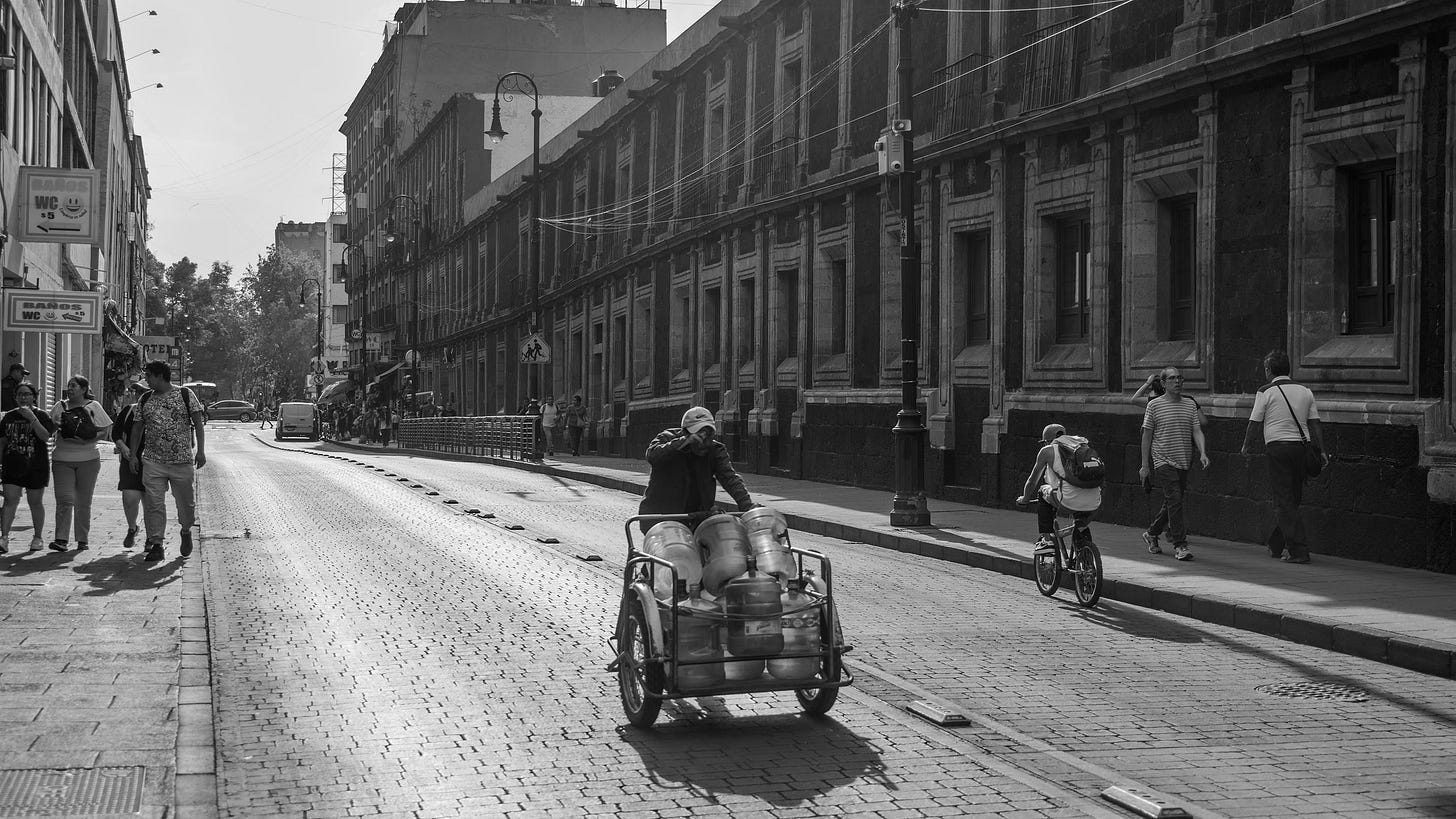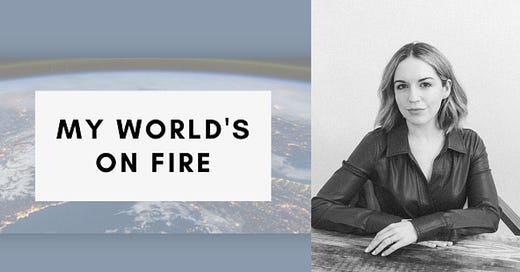Climate disaster journalist Colleen Hagerty on what matters most after the world stops watching
A leading voice in disaster journalism talks about what's left behind: the quiet recoveries, compounding traumas, and how trust and communication shapes preparedness.
Hurricane season is looming over the Gulf Coast and wildfire season is intensifying across North America, making journalist Colleen Hagerty’s reporting on natural disasters more urgent than ever.
This year has already been marred by record-setting blazes and a federal rollback of climate initiatives, and Hagerty’s work provides a crucial lens into how environmental crises collide with vulnerable communities and shifting political priorities.
With the U.S. President Donald Trump administration slashing funding for the Federal Emergency Management Agency (FEMA), the National Weather Service, and critical climate research, Hagerty’s investigations — like her Rolling Stone reporting on emergency alert systems — reveal how vulnerable the United States’ disaster response infrastructure has become. Her work, which has even been cited in Congressional investigations, exposes how these budget cuts threaten already-strained communities.
“I have never spoken to someone in emergency management who felt like they had the levels of funding even ahead of this administration that they really need,” she told me. “[This will] be more acute if we are losing people who have been doing these roles before.”
Hagerty’s newsletter, My World’s on Fire — shortlisted for a Covering Climate Now award — centers on what happens after headlines fade: the invisible recoveries, compounding traumas, and community-driven solutions that shape long-term resilience. Through her reporting for outlets like The New York Times, BBC, PBS, and The Washington Post, she maps the disconnect between government systems and the people they’re meant to serve while also documenting the extraordinary efforts of those bridging the gap.
In this edition of Depth Perception, we speak to Hagerty about this moment of growing uncertainty around climate mitigation and literacy. She also explains why effective disaster preparedness and response isn’t just about resources: it’s about trust, equity, and recognizing when to step in, and when to listen. This interview has been edited for conciseness and clarity. — Kelly Kimball
You’ve reported on disasters across formats, from feature stories to visual explainers. What drew you to disaster reporting, and how do you decide which part of a catastrophe to zoom in on?
I started my career off in television, and really loved that as a format. I worked in local news, which was an incredible way to build up journalism skills as a new reporter. I was reporting for a New York City TV station when Hurricane Sandy came through, and I remember being sent out to Staten Island. There was an idea that this was going to be bad, but also, I don't think anyone really conceptualized just how much of an impact this storm was going to have. I certainly didn’t.
I remember being there during the storm, hearing it outside my hotel room windows. The next morning, I was driving back out and seeing this immense destruction. I realized I'd gone there to cover the storm, but this was just the beginning of a bigger story. For the people there, this was the start of an incredible life change, and there was going to be so much that was important for journalists to convey.
As a freelancer now, I'm cognizant of not wanting to parachute into unfamiliar places. I try to look for threads connecting different situations I've seen before — issues with recovery, environmental challenges, mental health challenges, or school reopening issues. These threads appear even between different types of disasters. I ask: How can I bring my understanding of the background and challenges to different areas? How can I help increase disaster literacy in these places?
In your Rolling Stone piece on FEMA, you explore what dismantling or underfunding disaster response agencies could mean in practice. With President Trump proposing sharp funding cuts and workforce reductions, how vulnerable does that leave us, especially as disaster seasons intensify?
Yes, I think one thing I’ve really learned reporting in this space is just how complex disaster recovery systems are. I know, for me personally — and for many people I’ve interviewed — you hear about a disaster and immediately wonder, “Where is FEMA in this?” But FEMA has never been the first responder in the U.S. The way emergency management works is that it starts locally, then escalates to the state, and only reaches the federal level depending on the scale and need.
That structure is often invisible. Most people probably can’t name their city’s emergency management office… You usually only hear about them during major moments of crisis.
It also varies so much by place. I’ve talked to emergency managers who are also the fire chief or volunteers in rural areas, and I live in Los Angeles, which has a much more robust department. So it’s hard to speak about this as a “national” system; capacity looks really different depending on where you are.
That said, I have never spoken to someone in emergency management who felt like they had the levels of funding — even ahead of this administration — that they really need. Budgets are tight, federal grants often pay staff salaries, and many offices are still overloaded from COVID. These roles require coordination across agencies — NOAA, HHS, the Small Business Administration. We already had these issues, and I do feel safe saying that they will be more acute if we are losing people who have been doing these roles before.
“I have never spoken to someone in emergency management who felt like they had the levels of funding — even ahead of this administration — that they really need.” — Colleen Hagerty
You’ve reported on how survivors often face long, invisible recoveries — like losing jobs, dealing with insurance red tape, or displacement. What have you found to be the hidden costs that stick with people long after the world stops watching, and did any take you by surprise?
What surprised me most is that often the most challenging time comes after the first year. During that initial year after a disaster, there's typically an incredible swell of support: financially, media coverage, donations, and community engagement toward recovery. As time passes, other stories emerge, resources get directed elsewhere, and maintaining that energy becomes difficult at the community level.
I've reported on teenagers who missed milestones like prom; it may sound small compared to losing a home, but these losses can sometimes be felt even more acutely than the larger disaster. You're losing that sense of home that carried you through an important phase of life.
It's one of the toughest parts to report on because it's so personal and solutions are hard to identify. What I've found helpful is community connection, even if people are physically distant. For LA Fire survivors, there's a Discord group with channels for every issue you might encounter. People say, "I'm so glad someone else created this because I'm having this issue too."
The big picture: Documenting Mexico City’s water crisis

In the near future, Mexico City may run out of drinking water. As the parched megalopolis struggles to quench its thirst, scenes from one of the world’s largest and most populated cities show how water scarcity could one day impact people around the globe.
In “The Last Drops of Mexico City,” presented by Long Lead and Magnum Photos, Magnum photographer Jérôme Sessini documents the megalopolis’s diminished drinking water supply, fixing his lens on the people impacted most by this arid new reality. Learn more at mexicocitywater.longlead.com.
In 2023, you were a Solutions Journalism Network Complicating the Narratives fellow, where you looked at prescribed fire and other proactive measures. What have you learned about telling climate stories that don't just fall into doom and gloom or denial, while still providing honest and nuanced narratives about disasters?
During that fellowship on prescribed fire [which are routine planned burns meant to protect and maintain fire-prone ecosystems], I went into stories thinking the focus would be on the practice itself. The science is conclusive that certain environments respond well to prescribed burns, as practiced by Indigenous people historically and into the present. At the same time, it can be controversial due to smoke impacts on nearby communities.
What I ended up reporting on most was communication. In the different areas I visited, I often found people who seemed to be on opposite sides of an issue but actually shared the same hopes of protecting their communities; they just weren't communicating well together.
In New Mexico, I reported on an area where Forest Service prescribed burns escaped and largely destroyed historic communities. Now the Forest Service is tasked with recovery and preventing future fires. There's inherent tension and distrust, but what I realized was the lack of strong dialogue between these parties. There wasn't a way for people to voice concerns and be heard, to share their expertise about their unique water systems and community needs.
The community felt outsiders were dictating what should be done to their land despite their generational knowledge. Meanwhile, the Forest Service felt they faced hostility preventing them from implementing necessary measures. There was no format for sharing these perspectives. The regional Forest Service head's solution was to have people call him directly — impossible at scale.
Your newsletter, My World's on Fire, has built a community around disaster awareness and storytelling. What kinds of conversations are you having with readers — and what gives you hope right now?
This is actually a question I just asked my readers in a recent newsletter! I just celebrated the fifth anniversary since I started it.
When I started it during COVID-19, I [wanted] to deepen my knowledge and share what I was learning about the structure of emergency management and decades of research in this space. I wanted to understand why different federal organizations come in during disasters and make preparedness feel doable at any budget and life stage.
Over the past five years, so much has changed in this space, including my own experience with the LA fires at the start of this year. So when I hit the fifth anniversary of my newsletter, I turned to my audience and asked: “When your world was on fire, what did you do to get through it? How do you hold on to hope?”
It's been incredible to hear their responses. Very often the answer has been to find ways to help. Even if you're having a tough time, finding ways to be of service can be incredibly hopeful, both seeing others help and feeling like you're making a difference yourself.
Further reading from Colleen Hagerty
“What Dismantling FEMA Will Really Mean When the Next Disaster Strikes” (Rolling Stone, February 24, 2025)
“First Comes the Hurricane. Then Comes the Fire.” (Heatmap, November 25, 2024)
“When Floods Destroy Homes, Hidden Costs Can Devastate Survivors” (The New York Times, April 26, 2023)
“Inside the Patchwork World of Emergency Alerts” (Rolling Stone, October 9, 2024)
“How disasters are redefining the high school experience” (Teen Vogue, May 31, 2022)







